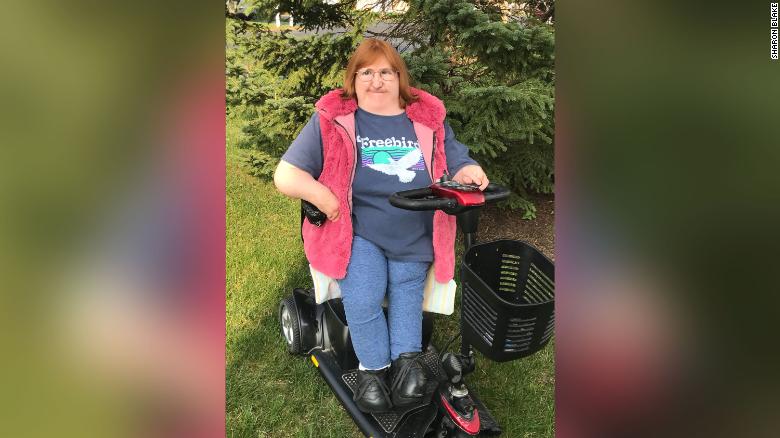Melissa Blake is a freelance writer and blogger from Illinois. She covers disability rights and women’s issues and has written for The New York Times, The Washington Post, Harper’s Bazaar, Good Housekeeping and Glamour, among others. Read her blog, So About What I Said, and follow her on Twitter. The views expressed in this commentary are solely hers. View more opinion on CNN.
When I was a teenager, someone said that I could never be a model because I’m disabled.
Those words stung. Not because they crushed my long-held dreams of becoming the next great fashion icon, but because they just reaffirmed society’s ableist thinking: That there was no place for disability in fashion.
This year, though, more than 20 years later, I modeled in New York Fashion Week (NYFW), where I got to wear an outfit from Zappos Adaptive and make a short video. It feels like a win for me, sure, but it’s a huge win for disability representation in fashion.
That win has been a long time coming (after years of discouragement) but it’s arrived at a moment when disability representation in everything from Halloween costumes to holiday films is improving. I hold on to these cultural victories all the more at a time when the political landscape for many disabled Americans feels especially precarious. I’d like to believe that, although the pandemic has robbed so many disabled people of health and access to needed services, the necessarily revised approach to what we wear and how we express ourselves in a Covid world may at least bring about long overdue (and hopefully lasting) changes in how we define fashion and beauty.
I’ve always admired fashion, but I never thought I’d actually be a part of it one day. Like so many teenagers, I grew up in the 1990s reading magazines like Cosmopolitan and Glamour, where the pages were filled with the likes of Cindy Crawford and Naomi Campbell. As I’d flip over each glossy page, I was always hoping to see disabled women like me, but I never did.
Where were the models in wheelchairs, I’d wonder? Where were the people who looked like me? The reality was that they just weren’t there, and this absence has as much to do with our society’s beauty standards as it does with fashion itself. These strict beauty standards dictate what is and isn’t considered beautiful and, by default, acceptable.
Traditionally, disabilities have not made the cut, but thanks to organizations like Runway of Dreams, those outdated standards are finally changing for the better. Founder Mindy Scheier started the non-profit in 2014; her son Oliver, who has a rare form of muscular dystrophy, wanted to dress like his friends, but couldn’t manage the buttons or zippers on regular jeans. She quickly realized just how much disabled people struggled to find clothes that were both fashionable and functional.
Six years later, Runway of Dreams promotes inclusion in the fashion industry with events like last month’s kick-off to NYFW, which went virtual this year during Covid-19. I joined more than 25 other disabled people in modeling adaptive clothing from Zappos Adaptive, Tommy Hilfiger, Target, Kohl’s and Stride Rite. We each modeled our outfits in video segments we shot from the comfort of home and our “catwalks” were interspersed with our stories of living with a disability and what it means to us to see the fashion industry making space for us instead of shutting us out like in the past.
It’s no secret that the fashion industry has been hit hard by the pandemic — everything from brick and mortar closures to fashion weeks going online. The way we shop and experience fashion is forever changed and part of that change revolves around fashion becoming more accessible — literally. More will be available online, which means more access for disabled people who may not be able to shop in person as easily.
Plus, having NYFW online this year actually allowed more people to watch it. This means that even more people (both disabled and non-disabled) were able to see a fashion show full of disability representation, and for disabled people especially, maybe it was the first time they saw someone like themselves on their TV screen. The fact that a virtual fashion show made up entirely of disabled people kicked off NYFW is revolutionary; it’s not something we would have seen even just 10 years ago.
Disability representation is happening off the runways too. Clothing brands are beginning to see the need for fashion that caters to disabled people. This year alone, Target once again released their line of adaptive costumes for children with disabilities and adaptive brand Intimately is launching two adaptive lingerie lines and a sleepwear collection specifically designed for disabled women.
It truly feels like I’m part of the disabled community’s fashion revolution. When we think of accessibility for disabled people, we typically think big stuff like buildings. But access should also apply to fashion, and including disabled people shows that they deserve a seat at the table in all aspects of life, frivolous or not.
Get our free weekly newsletter
Sign up for CNN Opinion’s new newsletter.
“To know that my son is going to grow up in a world that includes him — that believes that people with disabilities are just as important — to know we have a little bit of history in making that change happen is truly indescribable,” Scheier told People.
Indeed, seeing disability and fashion come together so beautifully tells us something pretty powerful: Disability inclusion is the ultimate fashion statement and forever on trend.
>>>details



